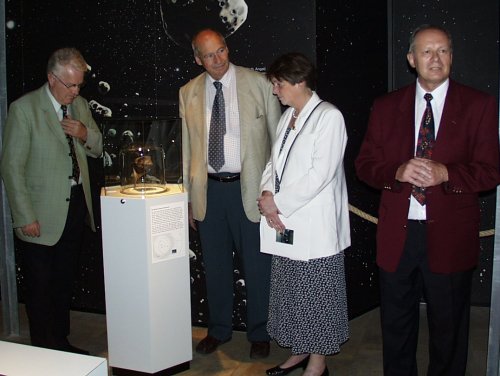The Neuschwanstein Meteorite


Juergen Oberst, Dieter Heinlein and Pavel Spurny, presenting
the Neuschwanstein 1.75 kg stony meteorite at the "Asteroids, Comets
and Meteors" meeting in Berlin.

Preparing the 1.75 kg Neuschwanstein meteorite for
gamma-ray spectroscopy at Max-Planck-Institute of Nuclear Physics in Heidelberg
(Low Level Laboratory).

The main mass of the Neuschwanstein meteorite was cut
at the Max-Planck-Institute of Chemistry, Mainz: it turned out to be a
rare Enstatite chondrite (EL6).

Anna & Otto H. had the honour to unveil the showcase
of the Neuschwanstein meteorite, located in the Riescrater Museum of Nördlingen,
on July 19, 2003.

Paul Kling (Mayor of Nördlingen), Prof. Dr. Hubert
Miller, Prof. Dr. Karin von Welck and Dr. Michael Schieber admiring the
1,7 kg Neuschwanstein meteorite.

Thomas and Nadin Grau, the young couple from Berlin,
that was happy enough to find the Neuschwanstein meteorite (on July 14,
2003) in the remote Alpine area.

Thomas Kurtz, who saw the April 6, 2002 fireball from
a distance of 600 km and who spent months searching for the meteorite
and Thomas Grau, who has found it.

The second fragment of the Neuschwanstein meteorite
weighing 1.63 kg was found on May 27, 2003 by two Bavarians very close
to the central line of the strewnfield.

Measuring the exact impact location of the 1,75 kg
framgent with GPS devices.

All-sky image of the Neuschwanstein fireball from EN
station #45 Streitheim.

Dieter Heinlein with the European Network Meteor Camera
#45 Streitheim.

European Network for Fireball Photography
by Marcel Vanek